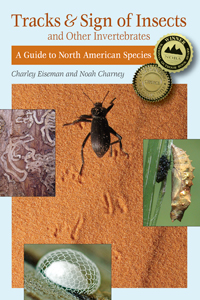In Idaho at the end of September, 2012, Julia and I noticed some striking green spots on dogwood leaves that were otherwise senescing.
As you may have noticed, each of them was centered along a major vein. When we flipped over the leaves, we found that in each green spot was a little yellow larva beneath the leaf epidermis, up against the vein.
I recognized them as gall midge larvae (Cecidomyiidae), and although this was strictly a leafminer collecting trip, these were interesting enough that I decided to make this one exception. Figuring that the larvae would soon be dropping to the ground to burrow and pupate, I half-filled a small container with soil and put the leaves on top. Within a few days all the larvae had disappeared into the soil, and I was unable to photograph them, but here is an example of the same species found in Vermont last September:
Last May, the pupae wriggled to the soil surface and the orange adult midges emerged, leaving their pupal exuviae sticking out of the soil.
Raymond J. Gagné examined the adults and confirmed that they were Parallelodiplosis subtruncata. This species was already known to make blister galls in dogwood leaves, but it had only been recorded from the east coast to Minnesota. In Dr. Gagné’s book the illustrated galls are between the major veins rather than centered on them, as shown here. Interestingly, in his key to dogwood galls, he says the galls made by this species are usually reddish, rather than green, which reminds me to talk about what’s going on there.
I recently finished reading Erich Martin Hering’s 1951 book, Biology of Leaf-miners. In pretty much every chapter, he made some reference to this “green island” phenomenon, then said he would discuss it in more detail in a later chapter. Finally, near the end, he got around to it, and after citing a number of observations and facts of plant physiology, he ruled out various possible explanations including anything having to do with the leaf-mining larva damaging the leaf’s veins, and concluded that there was something in the larva’s excrement that was causing the leaf to stay green only in the vicinity of the mine. One surprising observation someone had made decades earlier was that bird droppings that happened to land on leaves produced similar “green islands.”
I immediately wondered whether anyone had figured out more precisely what is happening, in the intervening 60+ years, and a quick Google search turned up a paper published in 2010: Plant green-island phenotype induced by leaf-miners is mediated by bacterial symbionts. The authors studied the larvae of Phyllonorycter blancardella (Gracillariidae), a moth that makes underside tentiform mines in apple leaves. They found that the larvae invariably contained endosymbiotic bacteria, Wolbachia, which manipulate levels of plant hormones called cytokinins, which control (among other things) leaf senescence. According to this article that summarizes the paper’s findings, around 60% of the world’s insects are infected with Wolbachia, so chances are pretty good that these gall midges are too.
The authors still hadn’t figured out exactly how the bacteria bring about the increased cytokinin levels, and they make no references to the larva’s excrement being involved, but it seems logical that incidentally excreted bacteria would be more able to affect the plant’s physiology than those remaining inside the caterpillar.
As for bird droppings having the same effect: the Wikipedia article on Wolbachia makes it sound like these bacteria only infect arthropods and nematodes, so I suppose that either other bacteria can also manipulate cytokinin levels, or there are nematodes in the bird droppings that cause green islands… unless something completely different is going on there. I’m used to studying fairly tiny things, but musings about microorganisms and molecules are definitely well outside my realm.
For an interesting example of a leafminer that relies on this phenomenon, see Seabrooke Leckie’s post about Ectoedemia argyropeza (Nepticulidae). This species has been introduced from Europe to eastern Canada, where it exists only as parthenogenetic females and is becoming extremely common. It mines in aspen leaves in the autumn, doing much of its feeding after the leaves have already fallen.











Pingback: permaculture Green Islands | BugTracks | Charley Eiseman | Permaculture Blog
Fascinating! You’ve introduced me to an area of insect/plant interaction that I was unfamiliar with — now I’ve got something new to look for next autumn.
Pingback: Green Islands (Part 2), and Another Mystery Moth | BugTracks
I loved the article and shared it on my FB page thank you, but just on a point that you might like to correct, the correct spelling is Parallelodiplosis
Whoops! Thanks for spotting that; it’s now fixed.
Pingback: Green Wasps from a Green Island | BugTracks
Pingback: Can gall midges be leafminers? | BugTracks